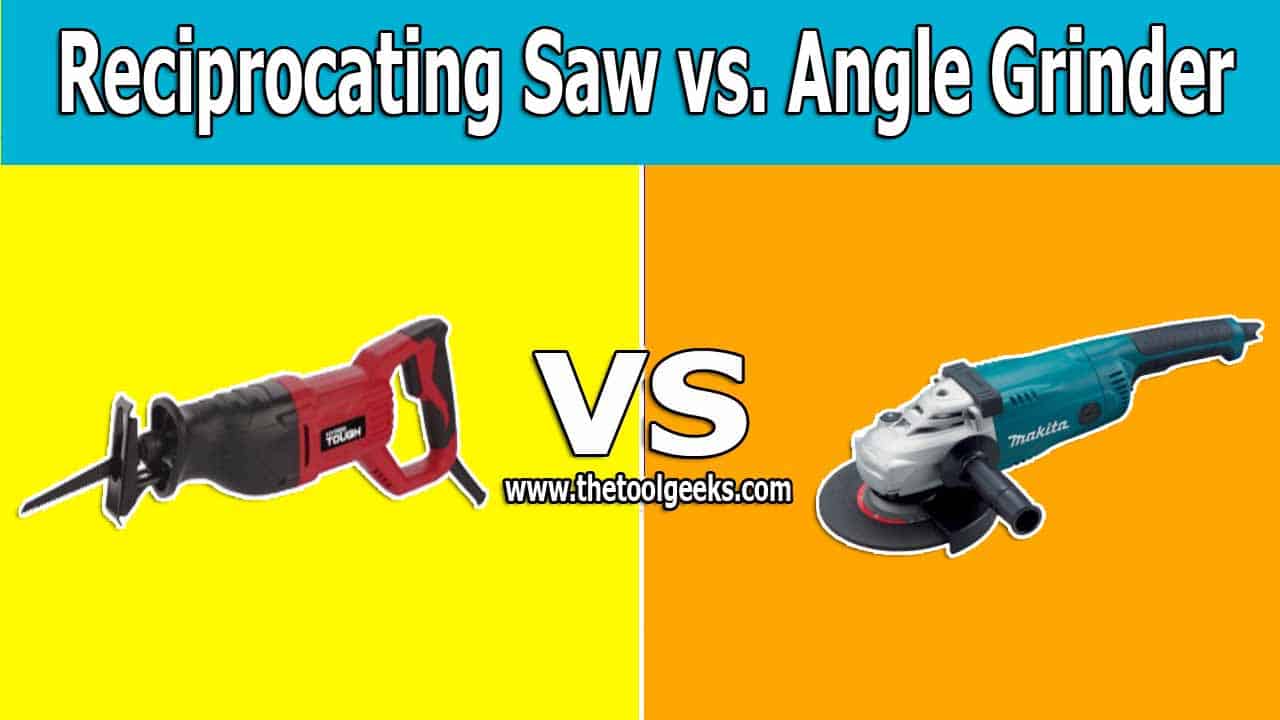Reciprocating Saws vs. Angle Grinders: 5 Differences Explained
TheToolGeeks.com is a participant in the Amazon Services LLC Associates Program and other affiliate advertising programs. We may earn from qualifying purchases. (Learn More).
Ready for your first demolition project but confused about whether to use a reciprocating saw or an angle grinder?
You’re not alone. Many beginners and DIYers face this problem so we decided to give a permanent solution to this dilemma.
While you may think both these tools are equally capable of breaking down metal objects, some important differences impact their performance.
So we’ve put together this guide to help you pick wisely and invest only in the best tool for you. Here we’ll tell you what the tools are used for at a basic level and then move on to comparing them side by side.
Ready? Let’s get started!
Reciprocating Saw vs. Angle Grinder
What is a Reciprocating Saw?
A reciprocating saw is one of the most common power tools you’ll find at any demolition site. The main reason for this is their versatility.
This two-handed power tool effectively breaks down any construction material with its end-mounted blade. This saw-style blade moves in a rapid back and forth motion cutting any material very quickly.
With that said, a standard reciprocating saw can typically cut most types of wood and thin metals without encountering any problem.
A reciprocating saw is also favored when working in confined spaces. Its extended outward blade cuts across doors and windows very easily which is mainly why handymen prefer it in tighter spaces. This quality makes them perfect for DIY projects too.
Read More — Battery Powered Sawzall Reviews
How does it function?
A reciprocating saw is made of many different components. Some of the most important parts are its blade, motor, battery, and power switch.
Once you turn it on, the motor moves a piston up and down which pushes a clamp. This clamp is responsible for the blade’s movement and its power depends mainly on the battery. The more battery it has the better the blade functions.
When working on more power there are not many materials that these teeth spare.
Pros and Cons of a Reciprocating Saw
Let’s see what makes a reciprocating saw an ideal tool for handymen and DIYers. Before you think we’re biased, we’ll be discussing the downsides of using a reciprocating saw too.
Read More — Best Electric Reciprocating Saws
Pros:
A reciprocating saw is a very versatile tool that can be used by professionals and DIYers. You can use it for remodeling projects, DIY projects that need to cut through wood or metals. The blades also make it a great tool to have at demolition sites or for mechanical projects.
Besides the different types of blades, you can also find many attachments to work with a reciprocating saw that has nothing to do with sawing. Some common examples are wire brushes, sponges, and scrapers.
Read More — Best Angle Grinders
Cons:
You’ll need a good knowledge of blades to use for various types of projects. Reciprocating saw blades need a lot of maintenance. You should change them as soon as you notice cutting being inhibited by the blade’s dullness.
What is an Angle Grinder?
An angle grinder is another versatile handheld power tool widely used for metal fabrication jobs. Whether you need a tool for cutting, grinding, deburring, or polishing an angle grinder comes very handy.
Instead of a blade, angle grinders use discs to operate. Like reciprocating saws, you do get the option to pick between the corded or cordless varieties.
The abrasive discs you select depend entirely on the application and material you are working with. What makes them a better choice is their easy accessibility.
Walk into any hardware store and you’re sure to find a plethora of angle grinders from different brands and in various models.
How does it function?
When it comes to cutting metal, you can save a lot of time and effort by choosing the right combination of an angle grinder and disc.
To use the machine, hold the grinder straight and use light pressure to guide it through the workpiece. Make sure each side of the metal is supported leaving no room for it to move and damage the blade as you are cutting.
Too much pressure is also not good for the blade as you’ll wear it out prematurely. This will have you replacing worn-out discs more often than you’d like.
Pros and Cons of an Angle Grinder
Why not get a reciprocating saw that is easier to work with?
Well, angle grinders may not be perfect for DIYers but they come with a lot of benefits. Let’s see what they are.
Pros:
Angle grinders are very versatile. Using them requires taking extra precautions but they are a great addition to every professional’s arsenal. An angle grinder with the right disc turns a tedious job much quicker. And of course, it also cuts the effort you’d put in otherwise.
If that’s not enough, they come in a series of different models and are manufactured by various brands.
Cons:
Not recommended for DIY projects as it’s primary functions are rarely required in such projects. The learning curve is bigger so you’ll be investing time and money before you learn to safely and efficiently use it.
How different are Reciprocating Saws and Angle Grinders?
Now that you know the basics of both the demolition tools, let’s put them side by side and look at their differences
Blade Shape:
A reciprocating saw blade is long, thin, and features saw-style teeth, while Angle grinders feature a small disc-shaped blade that is typically tapered from its center to the outer edge.
Body Style:
Reciprocating saws utilize an elongated rifle-style body, while Angle grinders come with a simple stick-like body.
Read More — How to Use a Reciprocating Saw Safely?
Cutting Capacity:
Reciprocating saws can only cut through thin metal objects, while Angle grinders can cut through thicker gauge metal objects.
Movement/Maneuverability:
Reciprocating saws design allows the blade to cut into tight spaces, while Angle grinders are maneuverable but not suitable for smaller spaces.
Cost:
Reciprocating saws cost approximately $80 to $300. For a replacement blade, you may need to spend around $15.
Angle grinders are quite cheaper in comparison. One unit costs around $45 to $180. The replacement discs are also priced as low as $10.
Which of the Two Do We Recommend?
Both tools can be used interchangeably for certain applications. However, we do not recommend using angle grinders in confined spaces.
When it comes to the power and cutting capacity, a reciprocating saw is far better. Its extended blade reaches in tiny spaces and yet perfectly cuts the material.
Whereas if your job requires the application of extreme force and space is not an issue, go for an angle grinder. It’ll cost a lot less and get the job done faster with minimum effort.
Read More — How to Cut Trees with a Reciprocating Saw?
Conclusion
As you know now, reciprocating saws and angle grinders are fairly different power tools. They only feature some functional overlaps other than that, these tools have separate applications and functions. For beginners, it’s best to use them for their functions.
However, if you want to get maximum returns from professional demolition jobs it’s best to have both these power tools on hand. DIYers, on the other hand, should steer clear from angle grinders and stick to using simple and compact reciprocating saws.
Important Note
No matter what you pick, a reciprocating saw or an angle grinder, you must take the necessary precautions before getting started.
Look at the instructions and read the user manual carefully then begin sawing. Get hold of the necessary gear to prevent any injuries. Follow the usage instructions cautiously and be aware of your surroundings.
Do not use angle grinders in smaller areas. This can cause injuries and even be fatal. Start cutting only after thoroughly learning how to use the power tool from its user manual. If you’re not sure how to go about the process, get professional assistance.
Amazon and the Amazon logo are trademarks of Amazon.com, Inc, or its affiliates.

